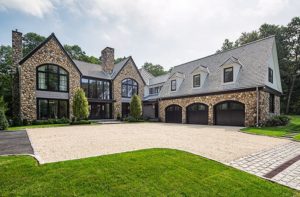Attention to Detail in Suburban Boston
May 7, 2019
Text by Regina Cole Photography by Michael J. Lee Produced by Kyle Hoepner
The colonial revival style was born when America celebrated its 100th birthday with the 1876 Philadelphia Centennial Exhibition. Nearly ten million visitors—about a fifth of the U.S. population at the time—attended and viewed the New England “colonial kitchen” exhibit, which sparked patriotic passion. That passion has never totally gone out of style.
In a suburb west of Boston, a superb early colonial revival house got a recent revival of its own. Built in 1881, the house displays the hallmarks of the style, including magnificent interior millwork: mantels, moldings, corbels, wainscots, and doors whose elaborate carvings pay homage to the seventeenth and eighteenth centuries and to classical mythology. In 11,000 square feet, the house has eight fireplaces, six bedrooms, and seven full baths.
Initially, what sold the homeowners on the place was not its historic character, but rather the way it is expressed. “I wanted a nice house with a little bit of land and interesting rooms,” says the wife. “I was not looking for a particular style; I simply like detail. This house has lots of that, and that’s what attracted me.”
But by 2013, when she and her husband found it, deferred maintenance had taken its toll.
“The house was sagging,” says architect Doug Okun, whose Cambridge, Massachusetts, firm headed up what became a five-year restoration and rebuilding project. “The studs had wicked moisture for 130 years and were rotted at the bottom so that they no longer met the sills. Literally, nothing was holding the house together.”
Of course, that detail didn’t reveal itself right away. “We didn’t know until we began work,” Okun says. “We didn’t expect to have to rebuild the house from the inside out.”
With structural engineering assistance from Winchester, Massachusetts-based Aberjona Engineering, the house was lifted up, new sills were installed, and a steel structural skeleton built.
Electrical and plumbing systems were replaced, and Okun and his crew added seven feet to the back of the house for a more spacious kitchen and dining room. “To match the new section to the old, we replicated the original millwork so you can’t tell that the house has an addition,” Okun says.
Before the beautiful old millwork could be copied, countless layers of paint had to be removed. “You couldn’t even see many of the carved details, there were so many heavy layers,” says Cambridge interior designer Heidi Pribell.
The front entrance packs a dramatic wallop with its vast, Jacobean-influenced fireplace, a grand staircase, and elaborately carved millwork. “One of the critical changes I made was to transform this space to look like a club rather than just a pass-through,” Pribell says. She installed new limestone flooring with terracotta insets and set a cozy seating arrangement in front of the welcoming fireplace. A delightful inglenook nestles under the stairs. “At first we thought we’d put a piano there,” the homeowner says,” but Heidi convinced us it would make a wonderful little sitting area.” On the coffered ceiling, Pribell applied pale wallpaper with gold reflective patches. “It’s a bit of glitter that brings light into a space that had been gloomy and dark,” she says.
In the paneled library off the entry hall, Pribell treated the woodwork to a saturated shade of blue. The color finds echoes in ceramics displayed on the shelves. “Because the China Trade was both a vital source of New England wealth and responsible for the marvelous history of blue-and-white ceramics, we were inspired to accessorize with Kangxi porcelain, Chinese exportware, Dutch delftware, and Canton,” she says.
The designer also carried the reflective paper of the entry ceiling to the walls between the bookshelves, creating a sense of continuity.
The living room fireplace, an elegant Georgian-style beauty, had been plastered over, Pribell says. “When we removed the board and plaster, we discovered a wealth of references to the natural and classical worlds, including a winged Medusa. Maybe it was covered because, in the Modernist age, such ornamentation was considered frivolous.”
To balance the restored fireplace wall, Pribell installed a paneled chair rail. Curtains descend from under a deep soffit designed and fabricated to match existing woodwork.
In the expanded dining room, Pribell specified floor-to-ceiling windows to make the nine-foot ceiling appear taller. She also introduced a touch of extra luxury with upholstered silk walls. For the furnishings, she chose calm tones of bisque and beige, a palette inspired by a sofa the owners brought from their previous home. It is now in the living room, upholstered in champagne damask. “Heidi knew that I want things subtle,” the homeowner says. “I want the interior architecture to be the focus of attention.”
The decor takes an ever-so-slightly more modern turn in the spacious new kitchen, where Pribell designed cabinetry inspired by the Arts and Crafts period, accented with pewter hardware. A double pendant in an antique nickel finish hangs above the quartzite-topped island.
The quiet hues of the public rooms give way to a lusher palette in the bedrooms. The master bedroom, for instance, features walls covered with luminous textured paper, damask draperies, woodwork painted pale yellow, and a ceiling of soft pink. The upholstered headboard, designed by Pribell, extends under the windows on each side and frames the nightstands.
A daughter’s room is more colorful still, with a pink upholstered bed and headboard and a graphic rug. Playful touches in an otherwise formal space include wainscot and crown molding painted lavender, an armchair and ottoman upholstered with draped pink velvet, and many layers of bobble fringe and embroidered rick-rack on the purple and gold draperies.
Another brilliant exception to the house’s neutral palette is the half bath off the front entry. Papered with dramatic gold and white wallcovering, the room has a red ceiling, a crystal ceiling fixture, a custom vanity topped with an agate counter, and a voluptuously curved gold-framed mirror.
Now that the house is not in danger of falling down, its jewel-box beauty can last while new generations fall for the colonial revival.
Project Team
Renovation architect: Doug Okun, Douglas Okun & Associates
Interior architecture and design: Heidi Pribell, Heidi Pribell Interior Design
Builder: Ramon Miranda, Lorena Construction Services
Share
![NEH-Logo_Black[1] NEH-Logo_Black[1]](https://www.nehomemag.com/wp-content/uploads/2022/08/NEH-Logo_Black1-300x162.jpg)























You must be logged in to post a comment.